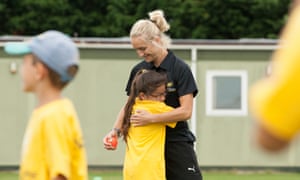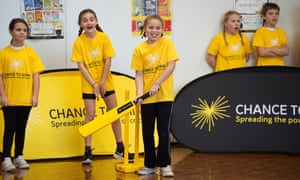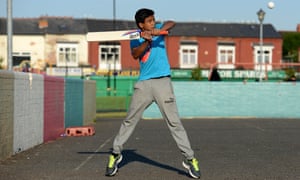Not out: how kids' cricket is staging a comeback | Cricket has no boundaries
Shakeel Ahmed, 23, is a community cricket coach in Middlesex, but he came to the game late. When he was younger, he wasn’t interested. “The traditional cricket club setup didn’t appeal to me,†he says. He was not alone. Despite cricket’s status as England’s national sport, wrestling stars are more recognisable to many of the country’s young people than record-breaking batsman Alastair Cook.
With traditional club games lasting around seven hours, England matches absent from free-to-air TV since 2005, and the majority of England players having been educated at private schools, the sport’s image is far from inclusive. Research by the England and Wales Cricket Board (ECB) last year found that only 2% of seven- to 15-year-olds say cricket is their favourite sport. But a growing grassroots cricket scene is reversing that trend.
Twelve years ago, the charity Chance to Shine was set up to reinvigorate the sport in state schools, introducing children to eight-over games lasting under an hour â€" and on 8 May, it announced its partnership with NatWest. What began as an experiment has morphed into one of the greatest successes in grassroots sport, with 400,000 children a year playing cricket through the programme.
In 2008, Chance to Shine launched another strand, Chance to Shine Street, designed to broaden cricket’s reach. This was Ahmed’s route into the sport. “I struggled a bit as a teenager and lacked direction,†he says. “When I came across street cricket, it helped me to focus on my studies more, feel included, increase my confidence and build my social skills.†Of the 3,000 who take part in this scheme every year, three-quarters are from black and minority ethnic backgrounds, and 45% of all Chance to Shine participants are girls.

The scheme provides free community cricket sessions and fast-paced, six-a-side matches in inner-city areas. Street games are often played in confined areas, so using a traditional ball would be asking for trouble. Tennis balls wrapped in electrical tape, known as tape-balls, are used instead â€" heavier and faster than tennis balls, but less destructive than traditional hard balls.
Chance to Shine’s work is only part of a broader movement to make cricket more accessible and inclusive with untapped communities. Last Man Stands, which organises eight-a-side games lasting no more than two hours on weekday evenings, had 13,000 players across 100 towns and cities in England in 2016 â€" up 22% on the previous year, says Richard Joyce, an operations manager for Chance to Shine. And Club T20, NatWest’s set of regional leagues for under 19s, attracted 7,000 players last year â€" up 43% on 2015. The number of indoor and tape-ball cricket leagues is also growing steadily.
Most significant of all, the ECB hopes, will be the new All Stars programme for children aged five to eight. Just under 2,000 cricket clubs across England and Wales â€" one-third of the total â€" have signed up as All Stars cricket centres and it’s hoped they will introduce up to 50,000 children to the game each summer. Working with primary-school children could help meet a wider challenge facing all team sports â€" that people are turning to solo pursuits such as cycling, swimming or going to the gym, that they can do in their own time. “The current generation has more leisure and lifestyle choices than ever before,†says Ben Walker, communications manager at the ECB.

Cricket’s rich history is one of its greatest assets but, at grassroots level, it has also been a burden. “Cricket can mean different things to different people,†says Joyce. “It’s not just about 20- or 30-over cricket at the weekend at the traditional cricket club and pavilion. We don’t want to undermine the traditional game, because there’s a lot that we know and love about cricket clubs, long games and teas, but there’s a lot more out there in 2017.â€
This approach is avowedly non-hierarchical, giving street cricket and indoor games the same respect as the traditional game. “You’re as much a cricketer if you’re playing tape-ball cricket in your leisure centre on a Wednesday night as if you’re playing an all-day game on a Sunday at a club where you’ve been a member for 15 years,†Joyce says. “A lot of people just want to play a bit of tape-ball cricket with their mates. That’s what cricket is to them - that’s absolutely fine.â€
This is not to say that people who start off with a tape-ball in their hands don’t move on to the traditional club game. “At all of our school programmes we look to push that club link,†explains Joyce. The process is two-way and constantly evolving â€" not just about educating new converts to cricket, but also teaching clubs with rich histories how to become more inclusive. “There’s been a huge move towards supporting clubs that may be more traditional in their outlook to make the game good fun and engaging for kids,†says Joyce.

It is estimated that 30-40% of grassroots cricketers are non-white, and yet this drops to just 6% of those playing first-class cricket. To address this, the ECB, in conjunction with the Equality and Human Rights Commission, recently invested £450,000 in training more black, ethnic minority and female coaches. The ECB has also invested £1m in a sports hall in Leicester to support indoor cricket, and £200,000 to improve pitches for the Birmingham Parks League, says Walker â€" both of which will particularly help South Asian cricket communities.
Chance to Shine, like other grassroots cricket schemes, was set up to enable young people to experience and enjoy the game, rather than uncover future professionals. Yet, five years ago, Zoey Cape, who was discovered through Chance to Shine, played for the Somerset women’s side. The charity dreams that, one day soon, a player they introduced to cricket could enjoy a professional career in the game.
“I wouldn’t like to put a deadline on it,†says Joyce. “I’d like to think that some of the young people we engage will feature in full England teams â€" whether that’s the men’s team, the women’s team or one of the disability teams.†Meanwhile, there are other benefits to the programme. As Ahmed says: “Playing street cricket was a major turnaround in my life, and now I help young people who might feel alienated get involved in the sport.â€
NatWest has supported cricket, the game for all, since 1981. NatWest are proud to be the principal partner of the England and Wales Cricket Board (ECB) and the official partner of Chance to Shine, reflecting the bank’s own values and commitment to fairness and inclusion.
To find out more visit natwest.com/noboundaries

0 Response to "Not out: how kids' cricket is staging a comeback | Cricket has no boundaries"
Posting Komentar